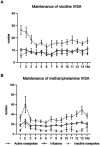The effect of CNQX on self-administration: present in nicotine, absent in methamphetamine model
- PMID: 38249125
- PMCID: PMC10796660
- DOI: 10.3389/fnbeh.2023.1305412
The effect of CNQX on self-administration: present in nicotine, absent in methamphetamine model
Abstract
Objective: Addiction is a chronic disease with limited pharmacological options for intervention. Focusing on reducing glutamate levels in the brain seems to be a promising strategy in addiction treatment research. Our research aimed to evaluate the effects of CNQX, an antagonist that targets AMPA and kainate glutamatergic receptors while also exhibiting affinity for the NMDA receptor, especially by modulating its glycine site. We conducted this assessment on the self-administration of nicotine and methamphetamine via intravenous (IV) administration in rats.
Methods: An operant IV self-administration model was used in male Wistar rats. When animals maintained a stable intake of nicotine or methamphetamine, we administered a single injection of CNQX (in the dose of 3 or 6 mg/kg IV) to evaluate its effect on drug intake. Subsequently, the rats were forced to abstain by staying in their home cages for 2 weeks. The period of abstinence was followed by a context-induced relapse-like session before which animals were pretreated with the injection of CNQX (3 or 6 mg/kg IV) to evaluate its effect on drug seeking.
Results: CNQX significantly reduced nicotine intake during the maintenance phase, but no effect was revealed on nicotine seeking after forced abstinence. CNQX did not affect methamphetamine taking or seeking.
Conclusion: The effect of reducing nicotine taking but not seeking could be explained by different involvement of glutamatergic receptors in various stages of nicotine dependence.
Keywords: AMPA/kainate receptor; CNQX; methamphetamine; nicotine; relapse; self-administration.
Copyright © 2024 Hrickova, Amchova and Ruda-Kucerova.
Conflict of interest statement
The authors declare that the research was conducted in the absence of any commercial or financial relationships that could be construed as a potential conflict of interest. The author(s) declared that they were an editorial board member of Frontiers, at the time of submission. This had no impact on the peer review process and the final decision.
Figures




Similar articles
-
Repeated administration of AMPA/kainate antagonists transiently suppresses nicotine-seeking in an operant rat model.Behav Brain Res. 2025 Oct 2;494:115742. doi: 10.1016/j.bbr.2025.115742. Epub 2025 Jul 16. Behav Brain Res. 2025. PMID: 40680996
-
NBQX attenuates relapse of nicotine seeking but not nicotine and methamphetamine self-administration in rats.World J Biol Psychiatry. 2021 Dec;22(10):733-743. doi: 10.1080/15622975.2021.1907714. Epub 2021 Apr 13. World J Biol Psychiatry. 2021. PMID: 33787469
-
Intermittent bilateral deep brain stimulation of the nucleus accumbens shell reduces intravenous methamphetamine intake and seeking in Wistar rats.J Neurosurg. 2017 Apr;126(4):1339-1350. doi: 10.3171/2016.4.JNS152524. Epub 2016 Jul 8. J Neurosurg. 2017. PMID: 27392268
-
Olfactory bulbectomy increases reinstatement of methamphetamine seeking after a forced abstinence in rats.Behav Brain Res. 2016 Jan 15;297:20-7. doi: 10.1016/j.bbr.2015.09.035. Epub 2015 Oct 22. Behav Brain Res. 2016. PMID: 26431766
-
Role of the glutamatergic system in nicotine dependence : implications for the discovery and development of new pharmacological smoking cessation therapies.CNS Drugs. 2008;22(9):705-24. doi: 10.2165/00023210-200822090-00001. CNS Drugs. 2008. PMID: 18698872 Review.
Cited by
-
Pharmacological Treatments for Methamphetamine Use Disorder: Current Status and Future Targets.Subst Abuse Rehabil. 2024 Aug 30;15:125-161. doi: 10.2147/SAR.S431273. eCollection 2024. Subst Abuse Rehabil. 2024. PMID: 39228432 Free PMC article. Review.
References
-
- Amchova P., Kucerova J., Giugliano V., Babinska Z., Zanda M. T., Scherma M., et al. . (2014). Enhanced self-administration of the CB1 receptor agonist WIN55, 212-2 in olfactory bulbectomized rats: evaluation of possible serotonergic and dopaminergic underlying mechanisms. Front. Pharmacol. 5:44. doi: 10.3389/fphar.2014.00044 - DOI - PMC - PubMed
LinkOut - more resources
Full Text Sources

